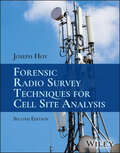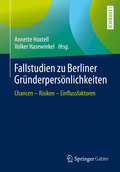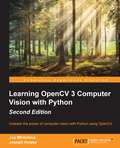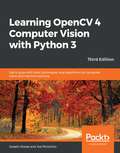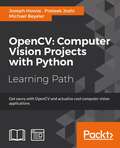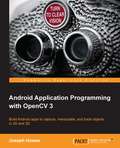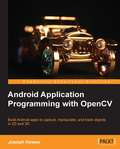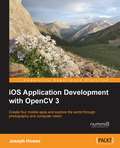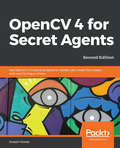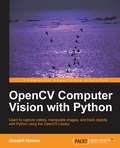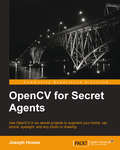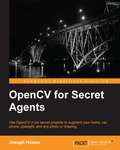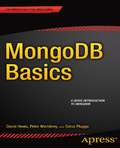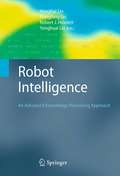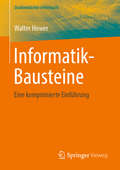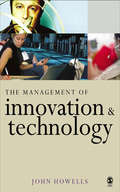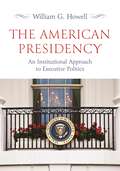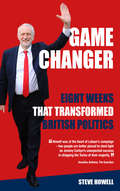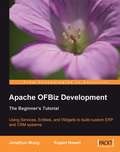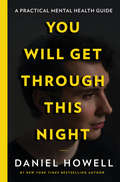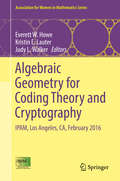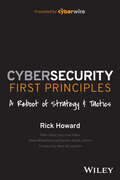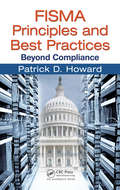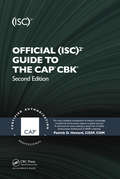- Table View
- List View
Forensic Radio Survey Techniques for Cell Site Analysis
by Joseph HoyFORENSIC RADIO SURVEY TECHNIQUES FOR CELL SITE ANALYSIS Overview of the end-to-end process of planning, undertaking, and reporting of forensic radio surveying to support cell site analysis The newly updated and revised Second Edition of Forensic Radio Survey Techniques for Cell Site Analysis provides an overview of the end-to-end process of planning, undertaking, and reporting of forensic radio surveying to support the forensic discipline of cell site analysis. It starts by recapping and explaining, in an accessible way, the theory, structure, and operation of cellular communications networks, then moves on to describe the techniques and devices employed to undertake forensic radio surveys. Worked examples are used throughout to demonstrate the practical steps required to plan and undertake forensic radio surveys, including the methods used to analyze radio survey data and compile it into a court report. A summary section condenses the technical and practical elements of the book into a handy reference resource for busy practitioners. The Second Edition contains 25% brand new material covering 5G New Radio networks and ‘6G and beyond,’ critical communications, mobile satellite communications, IoT networks, Cell Site Analysis Tools, and much more. Other sample topics covered in Forensic Radio Survey Techniques for Cell Site Analysis include: Radio theory, covering RF propagation, basic terminology, propagation modes, multipath transmission, and carrying information on a radio signal Core networks, including 2G, 3G, 4G, and 5G, subscriber and device identifiers, and international and temporary mobile subscriber identities Cell access control, covering cell barring, forbidden LAC/TAC, location updating, inter- and intra-carrier handovers, and 3GPP network types Forensic radio surveys objectives, terminology, and types, along with location, static spot, and indoor surveys The Second Edition of Forensic Radio Survey Techniques for Cell Site Analysis is an essential reference on the subject for police analysts, practitioners, technicians, investigators, and cell site experts, along with legal professionals and students/trainees in digital forensics.
Fallstudien zu Berliner Gründerpersönlichkeiten: Chancen – Risiken – Einflussfaktoren
by Annette Hoxtell Volker HasewinkelDieses Lehrbuch beschäftigt sich mit Gründerinnen und Gründern in verschiedenen Berliner Branchen mit ganz unterschiedlichen Lebensläufen und Hintergründen. Sie gründen alleine oder im Team, wollen reich werden oder die Welt verbessern und sind finanziell mehr oder weniger erfolgreich. Was sie verbindet, sind Risikobereitschaft, Engagement und Verantwortung: Sie sehen und ergreifen Chancen und nehmen dabei Risiken in Kauf, sie engagieren sich für ihre Idee und ihre Kunden und sie übernehmen Verantwortung für das eigene Tun, die Mitarbeiter und das eigene Unternehmen. Die vorgestellten Persönlichkeiten können Vorbilder für künftige Gründerinnen und Gründer sein, sie sind ein wesentlicher Teil der Wirtschaft und der Gesellschaft, sie schaffen Arbeitsplätze und sie zahlen Steuern. Die Autorinnen und Autoren der Fallstudien gehen der Frage nach, weshalb die jeweilige Persönlichkeit ihr Unternehmen gründete. Sie beleuchten Erfolge und Schwierigkeiten bis hin zum Scheitern und prüfen, ob es größere Zusammenhänge gibt, die eine Gründung beeinflussen. Die Fallstudien sollen einen Beitrag zur Forschung leisten und dazu anregen, aus den Geschichten der portraitierten Menschen zu lernen. Die Fallstudien eignen sich sowohl für den Einsatz in Lehrveranstaltungen als auch zum Selbststudium oder als inspirierende Lektüre für Menschen, die abwägen, ob und unter welchen Bedingungen eine Gründung für sie in Betracht kommt. Auch bereits Selbständige können durch die Beschäftigung mit den Fallstudien ihre eigene Tätigkeit reflektieren und Anregungen erhalten.
Learning OpenCV 3 Computer Vision with Python - Second Edition
by Joseph Howse Joe MinichinoUnleash the power of computer vision with Python using OpenCV About This Book * Create impressive applications with OpenCV and Python * Familiarize yourself with advanced machine learning concepts * Harness the power of computer vision with this easy-to-follow guide Who This Book Is For Intended for novices to the world of OpenCV and computer vision, as well as OpenCV veterans that want to learn about what's new in OpenCV 3, this book is useful as a reference for experts and a training manual for beginners, or for anybody who wants to familiarize themselves with the concepts of object classification and detection in simple and understandable terms. Basic knowledge about Python and programming concepts is required, although the book has an easy learning curve both from a theoretical and coding point of view. What You Will Learn * Install and familiarize yourself with OpenCV 3's Python API * Grasp the basics of image processing and video analysis * Identify and recognize objects in images and videos * Detect and recognize faces using OpenCV * Train and use your own object classifiers * Learn about machine learning concepts in a computer vision context * Work with artificial neural networks using OpenCV * Develop your own computer vision real-life application In Detail OpenCV 3 is a state-of-the-art computer vision library that allows a great variety of image and video processing operations. Some of the more spectacular and futuristic features such as face recognition or object tracking are easily achievable with OpenCV 3. Learning the basic concepts behind computer vision algorithms, models, and OpenCV's API will enable the development of all sorts of real-world applications, including security and surveillance. Starting with basic image processing operations, the book will take you through to advanced computer vision concepts. Computer vision is a rapidly evolving science whose applications in the real world are exploding, so this book will appeal to computer vision novices as well as experts of the subject wanting to learn the brand new OpenCV 3.0.0. You will build a theoretical foundation of image processing and video analysis, and progress to the concepts of classification through machine learning, acquiring the technical know-how that will allow you to create and use object detectors and classifiers, and even track objects in movies or video camera feeds. Finally, the journey will end in the world of artificial neural networks, along with the development of a hand-written digits recognition application. Style and approach This book is a comprehensive guide to the brand new OpenCV 3 with Python to develop real-life computer vision applications.
Learning OpenCV 4 Computer Vision with Python 3: Get to grips with tools, techniques, and algorithms for computer vision and machine learning, 3rd Edition
by Joseph Howse Joe MinichinoUpdated for OpenCV 4 and Python 3, this book covers the latest on depth cameras, 3D tracking, augmented reality, and deep neural networks, helping you solve real-world computer vision problems with practical code Key Features Build powerful computer vision applications in concise code with OpenCV 4 and Python 3 Learn the fundamental concepts of image processing, object classification, and 2D and 3D tracking Train, use, and understand machine learning models such as Support Vector Machines (SVMs) and neural networks Book Description Computer vision is a rapidly evolving science, encompassing diverse applications and techniques. This book will not only help those who are getting started with computer vision but also experts in the domain. You'll be able to put theory into practice by building apps with OpenCV 4 and Python 3. You'll start by understanding OpenCV 4 and how to set it up with Python 3 on various platforms. Next, you'll learn how to perform basic operations such as reading, writing, manipulating, and displaying still images, videos, and camera feeds. From taking you through image processing, video analysis, and depth estimation and segmentation, to helping you gain practice by building a GUI app, this book ensures you'll have opportunities for hands-on activities. Next, you'll tackle two popular challenges: face detection and face recognition. You'll also learn about object classification and machine learning concepts, which will enable you to create and use object detectors and classifiers, and even track objects in movies or video camera feed. Later, you'll develop your skills in 3D tracking and augmented reality. Finally, you'll cover ANNs and DNNs, learning how to develop apps for recognizing handwritten digits and classifying a person's gender and age. By the end of this book, you'll have the skills you need to execute real-world computer vision projects. What you will learn Install and familiarize yourself with OpenCV 4's Python 3 bindings Understand image processing and video analysis basics Use a depth camera to distinguish foreground and background regions Detect and identify objects, and track their motion in videos Train and use your own models to match images and classify objects Detect and recognize faces, and classify their gender and age Build an augmented reality application to track an image in 3D Work with machine learning models, including SVMs, artificial neural networks (ANNs), and deep neural networks (DNNs) Who this book is for If you are interested in learning computer vision, machine learning, and OpenCV in the context of practical real-world applications, then this book is for you. This OpenCV book will also be useful for anyone getting started with computer vision as well as experts who want to stay up-to-date with OpenCV 4 and Python 3. Although no prior knowledge of image processing, computer vision or machine learning is required, familiarity with basic Python programming is a must.
OpenCV: Computer Vision Projects with Python
by Joseph Howse Prateek Joshi Michael Beyeler<P><P>About This Book <P><P>Use OpenCV's Python bindings to capture video, manipulate images, and track objects <P><P>Learn about the different functions of OpenCV and their actual implementations. <P><P>Develop a series of intermediate to advanced projects using OpenCV and Python <P><P>Who This Book Is For <P><P>This learning path is for someone who has a working knowledge of Python and wants to try out OpenCV. This Learning Path will take you from a beginner to an expert in computer vision applications using OpenCV. OpenCV's application are humongous and this Learning Path is the best resource to get yourself acquainted thoroughly with OpenCV. <P><P>What You Will Learn <P><P>Install OpenCV and related software such as Python, NumPy, SciPy, OpenNI, and SensorKinect - all on Windows, Mac or Ubuntu <P><P>Apply "curves" and other color transformations to simulate the look of old photos, movies, or video games <P><P>Apply geometric transformations to images, perform image filtering, and convert an image into a cartoon-like image <P><P>Recognize hand gestures in real time and perform hand-shape analysis based on the output of a Microsoft Kinect sensor <P><P>Reconstruct a 3D real-world scene from 2D camera motion and common camera reprojection techniques <P><P>Detect and recognize street signs using a cascade classifier and support vector machines (SVMs) <P><P>Identify emotional expressions in human faces using convolutional neural networks (CNNs) and SVMs <P><P>Strengthen your OpenCV2 skills and learn how to use new OpenCV3 features <P><P>In Detail <P><P>OpenCV is a state-of-art computer vision library that allows a great variety of image and video processing operations. OpenCV for Python enables us to run computer vision algorithms in real time. This learning path proposes to teach the following topics. First, we will learn how to get started with OpenCV and OpenCV3's Python API, and develop a computer vision application that tracks body parts. Then, we will build amazing intermediate-level computer vision applications such as making an object disappear from an image, identifying different shapes, reconstructing a 3D map from images , and building an augmented reality application, Finally, we'll move to more advanced projects such as hand gesture recognition, tracking visually salient objects, as well as recognizing traffic signs and emotions on faces using support vector machines and multi-layer perceptrons respectively. <P><P>This Learning Path combines some of the best that Packt has to offer in one complete, curated package. It includes content from the following Packt products:
Android Application Programming with OpenCV
by Joseph HowseA step-by-step tutorial to help you master computer vision and mobile app development.This book is for Java developers who are new to computer vision and who would like to learn about how it is used in relation to application development. It is assumed that you have previous experience in Java, but not necessarily Android. A basic understanding of image data (for example pixels and color channels) would be helpful too. You are expected to have a mobile device running Android 2.2 (Froyo) or greater and it must have a camera.
Android Application Programming with OpenCV
by Joseph HowseA step-by-step tutorial to help you master computer vision and mobile app development.This book is for Java developers who are new to computer vision and who would like to learn about how it is used in relation to application development. It is assumed that you have previous experience in Java, but not necessarily Android. A basic understanding of image data (for example pixels and color channels) would be helpful too. You are expected to have a mobile device running Android 2.2 (Froyo) or greater and it must have a camera
iOS Application Development with OpenCV 3
by Joseph HowseCreate four mobile apps and explore the world through photography and computer vision About This Book * Efficiently harness iOS and OpenCV to capture and process high-quality images at high speed * Develop photographic apps and augmented reality apps quickly and easily * Detect, recognize, and morph faces and objects Who This Book Is For If you want to do computational photography and computer vision on Apple's mobile devices, then this book is for you. No previous experience with app development or OpenCV is required. However, basic knowledge of C++ or Objective-C is recommended. What You Will Learn * Use Xcode and Interface Builder to develop iOS apps * Obtain OpenCV's standard modules and build extra modules from source * Control all the parameters of the iOS device's camera * Capture, save, and share photos and videos * Analyze colors, shapes, and textures in ordinary and specialized photographs * Blend and compare images to create special photographic effects and augmented reality tools * Detect faces and morph facial features * Classify coins and other objects In Detail iOS Application Development with OpenCV 3 enables you to turn your smartphone camera into an advanced tool for photography and computer vision. Using the highly optimized OpenCV library, you will process high-resolution images in real time. You will locate and classify objects, and create models of their geometry. As you develop photo and augmented reality apps, you will gain a general understanding of iOS frameworks and developer tools, plus a deeper understanding of the camera and image APIs. After completing the book's four projects, you will be a well-rounded iOS developer with valuable experience in OpenCV. Style and approach The book is practical, creative, and precise. It shows you the steps to create and customize five projects that solve important problems for beginners in mobile app development and computer vision. Complete source code and numerous visual aids are included in each chapter. Experimentation is an important part of the book. You will use computer vision to explore the real world, and then you will refine the projects based on your findings.
OpenCV 4 for Secret Agents: Use OpenCV 4 in secret projects to classify cats, reveal the unseen, and react to rogue drivers, 2nd Edition
by Joseph HowseTurn futuristic ideas about computer vision and machine learning into demonstrations that are both functional and entertainingKey FeaturesBuild OpenCV 4 apps with Python 2 and 3 on desktops and Raspberry Pi, Java on Android, and C# in UnityDetect, classify, recognize, and measure real-world objects in real-timeWork with images from diverse sources, including the web, research datasets, and various camerasBook DescriptionOpenCV 4 is a collection of image processing functions and computer vision algorithms. It is open source, supports many programming languages and platforms, and is fast enough for many real-time applications. With this handy library, you’ll be able to build a variety of impressive gadgets.OpenCV 4 for Secret Agents features a broad selection of projects based on computer vision, machine learning, and several application frameworks. To enable you to build apps for diverse desktop systems and Raspberry Pi, the book supports multiple Python versions, from 2.7 to 3.7. For Android app development, the book also supports Java in Android Studio, and C# in the Unity game engine. Taking inspiration from the world of James Bond, this book will add a touch of adventure and computer vision to your daily routine. You’ll be able to protect your home and car with intelligent camera systems that analyze obstacles, people, and even cats. In addition to this, you’ll also learn how to train a search engine to praise or criticize the images that it finds, and build a mobile app that speaks to you and responds to your body language.By the end of this book, you will be equipped with the knowledge you need to advance your skills as an app developer and a computer vision specialist.What you will learnDetect motion and recognize gestures to control a smartphone gameDetect car headlights and estimate their distanceDetect and recognize human and cat faces to trigger an alarmAmplify motion in a real-time video to show heartbeats and breathsMake a physics simulation that detects shapes in a real-world drawingBuild OpenCV 4 projects in Python 3 for desktops and Raspberry PiDevelop OpenCV 4 Android applications in Android Studio and UnityWho this book is forIf you are an experienced software developer who is new to computer vision or machine learning, and wants to study these topics through creative projects, then this book is for you. The book will also help existing OpenCV users who want upgrade their projects to OpenCV 4 and new versions of other libraries, languages, tools, and operating systems. General familiarity with object-oriented programming, application development, and usage of operating systems (OS), developer tools, and the command line is required.
OpenCV Computer Vision with Python
by Joseph HowseA practical, project-based tutorial for Python developers and hobbyists who want to get started with computer vision with OpenCV and Python.OpenCV Computer Vision with Python is written for Python developers who are new to computer vision and want a practical guide to teach them the essentials. Some understanding of image data (for example, pixels and color channels) would be beneficial. At a minimum you will need access to at least one webcam. Certain exercises require additional hardware like a second webcam, a Microsoft Kinect or an OpenNI-compliant depth sensor such as the Asus Xtion PRO.
OpenCV for Secret Agents
by Joseph HowseThis book is for programmers who want to expand their skills by building fun, smart, and useful systems with OpenCV. The projects are ideal in helping you to think creatively about the uses of computer vision, natural user interfaces, and ubiquitous computers (in your home, car, and hand).
OpenCV for Secret Agents
by Joseph Howse<P><P>Use OpenCV in six secret projects to augment your home, car, phone, eyesight, and any photo or drawing <P><P>About This Book <P><P>Build OpenCV apps for the desktop, the Raspberry Pi, Android, and the Unity game engine <P><P>Learn real-time techniques that can be used to classify images, detecting and recognizing any person or animal, and studying motion and distance with superhuman precision <P><P>Design hands-free interfaces that are practical in home automation, in cars, and in discrete surveillance <P><P>Who This Book Is For <P><P>This book is for programmers who want to expand their skills by building fun, smart, and useful systems with OpenCV. The projects are ideal in helping you to think creatively about the uses of computer vision, natural user interfaces, and ubiquitous computers (in your home, car, and hand). <P><P>What You Will Learn <P><P>Install OpenCV, a Python development environment, and an Android development environment on Windows, Mac, or Linux and install a Unity development environment on Windows or Mac <P><P>Get to grips with motion detection and gesture recognition as a means of controlling a guessing game on a smartphone <P><P>Detect car headlights, estimate distances to them, and provide feedback to the driver <P><P>Spot and recognize human faces and cat faces as a means of controlling an alarm <P><P>Amplify motion in real-time video so that a person's heartbeat and breathing become clearly visible <P><P>Draw a ball-in-a-maze puzzle on paper and see it come to life as a physics simulation on a smartphone <P><P>Integrate OpenCV with other libraries, as well as popular frameworks for GUI apps and games <P><P>In Detail <P><P>OpenCV is a grand collection of image processing functions and computer vision algorithms. It is open source, it supports many programming languages and platforms, and it is fast enough for many real-time applications. What a lot of gadgets we can build with such a handy library! <P><P>Taking inspiration from the world of James Bond, this book adds a spark of adventure and computer vision to your daily routine. Protect your home and car with intelligent camera systems that analyze people, cats, and obstacles. Let your search engine praise or criticize the images that it finds. Hear a voice from your phone that responds to your body language. Attune yourself to another person's rhythm by glancing at a display that magnifies a heartbeat or a breath. Learn OpenCV and see your world as never before.
MongoDB Basics
by David Hows Peter Membrey Eelco PluggeNeed a quick and easy to understand introduction to MongoDB and NoSQL databases? MongoDB Basics, from The Definitive Guide to MongoDB, 2E, shows you how a document-oriented database system differs from a relational database, and how to install and get started using it. You'll also learn MongoDB design basics, including geospatial indexing, how to navigate, view, and query your database, and how to use GridFS with a bit of Python.
Robot Intelligence
by Robert J. Howlett Dongbing Gu Honghai Liu Yonghuai LiuRobot intelligence has become a major focus of intelligent robotics. Recent innovation in computational intelligence including fuzzy learning, neural networks, evolutionary computation and classical Artificial Intelligence provides sufficient theoretical and experimental foundations for enabling robots to undertake a variety of tasks with reasonable performance. This book reflects the recent advances in the field from an advanced knowledge processing perspective; there have been attempts to solve knowledge based information explosion constraints by integrating computational intelligence in the robotics context.
Informatik-Bausteine: Eine komprimierte Einführung (Studienbücher Informatik)
by Walter HowerDieses Lehrbuch präsentiert prüfungsrelevantes Basismaterial für Bachelor-Studierende informatiknaher Studiengänge an Hochschulen und Universitäten. Es kombiniert die Themen Diskrete Mathematik, Theoretische Informatik, Algorithmik und Künstliche Intelligenz in einem Band. Die prägnante Form zielt auf eine effiziente Vorbereitung der jeweiligen Prüfung ab; hierzu hilft auch das wohlsortierte Sachwort-Verzeichnis am Ende dieses handlichen Werkes.
The Management of Innovation and Technology: The Shaping of Technology and Institutions of the Market Economy
by Dr John Howells`The book provides a valuable resource for researchers, practitioners and policy-makers... In particular, it provides a good introduction to broader aspects of the field of innovation for researchers based within the engineering and science traditions' - Journal of Manufacturing Technology Management `Howells has synthesised a broad range of sources with considerable insight to provide the first sophisticated single volume on innovation that draws on economics, sociology, law and from the history of science and technology. By setting innovation in social and institutional context, he convincingly shows how firms and markets shape and can be shaped by the decisions of managers and entrepreneurs. I will certainly be using this book as a central text for my Masters degree teaching on innovation management, management of technology and related topics' - Jonathan Liebenau, London School of Economics and Columbia University `A great strength of the book is the extensive and detailed integration of rich case study analyses into the main flow of the argument. Many apparently well known cases are revisited and critically assessed to draw clear and often contrary to popular belief lessons. This is a highly original and commendable feature of this text. It provides an unusually strong integration between theory and examples. And there is no doubt of the relevance of the examples: they are not inserted as an afterthought, but are intrinsically part of the development of the thinking' - Professor James Fleck, Head of Entrepreneurship and Innovation Group, University of Edinburgh Management School This book analyses a range of social contexts in which human decisions shape technology in the market economy. It comprises a critical review of both a select research literature and in-depth historical studies. Material is drawn from many social science disciplines to inform the reader of the reality of taking decisions on innovation. The chapters cover: - The social context for individual acts of creative insight - The development of the technology-market relationship - The management of R&D and technological standards - Technological competition - The role of institutions of finance in innovation - The reciprocal relationship between intellectual property law and technological innovation. - The role of technological skills and regimes of technological education in innovation. - An introduction to the role of the state in maintaining the innovative capacity of the private sector.
The American Presidency: An Institutional Approach to Executive Politics
by William G. HowellHow institutions shape the American presidencyThis incisive undergraduate textbook emphasizes the institutional sources of presidential power and executive governance, enabling students to think more clearly and systematically about the American presidency at a time when media coverage of the White House is awash in anecdotes and personalities. William Howell offers unparalleled perspective on the world’s most powerful office, from its original design in the Constitution to its historical growth over time; its elections and transitions to governance; its interactions with Congress, the courts, and the federal bureaucracy; and its persistent efforts to shape public policy. Comprehensive in scope and rooted in the latest scholarship, The American Presidency is the perfect guide for studying the presidency at a time of acute partisan polarization and popular anxiety about the health and well-being of the republic.Focuses on the institutional structures that presidents must navigate, the incentives and opportunities that drive them, and the constraints they routinely confrontShows how legislators, judges, bureaucrats, the media, and the broader public shape the contours and limits of presidential powerEncourages students to view the institutional presidency as not just an object of study but a way of thinking about executive politicsHighlights the lasting effects of important historical moments on the institutional presidencyEnables students to grapple with enduring themes of power, rules, norms, and organization that undergird democracy
GAME CHANGER Eight Weeks That Transformed British Politics: Inside Corbyn's Election Machine
by Steve Howell'If you want to get the inside account of Labour's historic general election campaign, I couldn't recommend more former Corbyn staffer Steve Howell's Game Changer.' Owen Jones'Game Changer is a vivid account of what it was like to be in the engine room of Jeremy Corbyn's remarkable election campaign.' Dennis Kavanagh, Emeritus Professor of Politics, University of LiverpoolWhen Theresa May called a snap election in 2017, Labour was more than twenty points behind in the polls and it seemed the only question was how big her landslide would be. In the most dramatic election of modern times, Corbyn's inspirational campaign transformed British politics. Labour won its best vote for twenty years and the largest increase in its vote share since 1945. Far from winning a landslide, the Tories were left without a majority and forced to abandon many of their unpopular plans.Steve Howell was at the centre of Corbyn's election machine. A member of the Labour leader's strategy group, he was involved in all the key campaign decisions. From the outset, he believed that Corbyn's campaigning skills, enthusiastic army of supporters and hopeful message could produce a surge in support. In Game Changer, he tells the story of eight weeks that transformed British politics.
GAME CHANGER Eight Weeks That Transformed British Politics: Inside Corbyn’s Election Machine
by Steve Howell'If you want to get the inside account of Labour's historic general election campaign, I couldn't recommend more former Corbyn staffer Steve Howell's Game Changer.' Owen Jones'Game Changer is a vivid account of what it was like to be in the engine room of Jeremy Corbyn's remarkable election campaign.' Dennis Kavanagh, Emeritus Professor of Politics, University of Liverpool When Theresa May called a snap election in 2017, Labour was more than twenty points behind in the polls and it seemed the only question was how big her landslide would be. In the most dramatic election of modern times, Corbyn's inspirational campaign transformed British politics. Labour won its best vote for twenty years and the largest increase in its vote share since 1945. Far from winning a landslide, the Tories were left without a majority and forced to abandon many of their unpopular plans.Steve Howell was at the centre of Corbyn's election machine. A member of the Labour leader's strategy group, he was involved in all the key campaign decisions. From the outset, he believed that Corbyn's campaigning skills, enthusiastic army of supporters and hopeful message could produce a surge in support. In Game Changer, he tells the story of eight weeks that transformed British politics.
Apache OFBiz Development: The Beginner's Tutorial
by Rupert Howell Jonathon WongThis is an accessible step-by-step tutorial that introduces readers to the world of OFBiz through practical examples and clear explanations. It will guide you through the framework, teach you to tweak OFBiz and master widgets, entities, and permissions, and give you the knowledge to customize your own bespoke applications. This book is for developers who want to build easily deployed and supported OFBiz applications. No previous knowledge of OFBiz is assumed, but readers should be comfortable in a Java development environment.
You Will Get Through This Night
by Daniel HowellA practical guide to taking control of your mental health for today, tomorrow, and the days after, from the #1 New York Times bestselling author and beloved entertainer. ‘There’s a moment at the end of every day, where the world falls away and you are left alone with your thoughts. A reckoning, when the things you have been pushing to the background, come forward and demand your attention.’ Written by Daniel Howell, in consultation with a qualified psychologist, in an entertaining and personal way from the perspective of someone who has been through it all—this no-nonsense book gives you the tools to understand your mind so you can be in control and really live. Split into three chapters for each stage of the journey: This Night - how to get through your toughest moments and be prepared to face anything. Tomorrow - small steps to change your thoughts and actions with a big impact on your life. The Days After - help to look after yourself in the long term and not just survive, but thrive. You will laugh and learn—but most of all, this book will assure you that even in your darkest times, there is always hope. You will get through this night.
Algebraic Geometry for Coding Theory and Cryptography: IPAM, Los Angeles, CA, February 2016 (Association for Women in Mathematics Series #9)
by Everett W. Howe Kristin E. Lauter Judy L. WalkerCovering topics in algebraic geometry, coding theory, and cryptography, this volume presents interdisciplinary group research completed for the February 2016 conference at the Institute for Pure and Applied Mathematics (IPAM) in cooperation with the Association for Women in Mathematics (AWM). The conference gathered research communities across disciplines to share ideas and problems in their fields and formed small research groups made up of graduate students, postdoctoral researchers, junior faculty, and group leaders who designed and led the projects. Peer reviewed and revised, each of this volume's five papers achieves the conference's goal of using algebraic geometry to address a problem in either coding theory or cryptography. Proposed variants of the McEliece cryptosystem based on different constructions of codes, constructions of locally recoverable codes from algebraic curves and surfaces, and algebraic approaches to the multicast network coding problem are only some of the topics covered in this volume. Researchers and graduate-level students interested in the interactions between algebraic geometry and both coding theory and cryptography will find this volume valuable.
Cybersecurity First Principles: A Reboot of Strategy and Tactics
by Rick HowardThe first expert discussion of the foundations of cybersecurity In Cybersecurity First Principles, Rick Howard, the Chief Security Officer, Chief Analyst, and Senior fellow at The Cyberwire, challenges the conventional wisdom of current cybersecurity best practices, strategy, and tactics and makes the case that the profession needs to get back to first principles. The author convincingly lays out the arguments for the absolute cybersecurity first principle and then discusses the strategies and tactics required to achieve it. In the book, you'll explore: Infosec history from the 1960s until the early 2020s and why it has largely failed What the infosec community should be trying to achieve instead The arguments for the absolute and atomic cybersecurity first principle The strategies and tactics to adopt that will have the greatest impact in pursuing the ultimate first principle Case studies through a first principle lens of the 2015 OPM hack, the 2016 DNC Hack, the 2019 Colonial Pipeline hack, and the Netflix Chaos Monkey resilience program A top to bottom explanation of how to calculate cyber risk for two different kinds of companies This book is perfect for cybersecurity professionals at all levels: business executives and senior security professionals, mid-level practitioner veterans, newbies coming out of school as well as career-changers seeking better career opportunities, teachers, and students.
FISMA Principles and Best Practices: Beyond Compliance
by Patrick D. HowardWhile many agencies struggle to comply with Federal Information Security Management Act (FISMA) regulations, those that have embraced its requirements have found that their comprehensive and flexible nature provides a sound security risk management framework for the implementation of essential system security controls. Detailing a proven appro
Official ((isc)2 Press Ser.)
by Patrick D. HowardSignificant developments since the publication of its bestselling predecessor, Building and Implementing a Security Certification and Accreditation Program, warrant an updated text as well as an updated title. Reflecting recent updates to the Certified Authorization Professional (CAP) Common Body of Knowledge (CBK) and NIST SP 800-37, the Official
